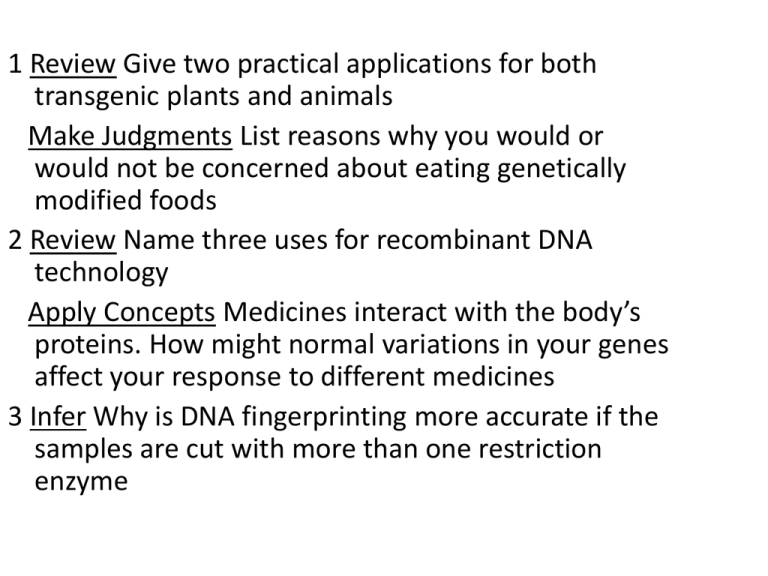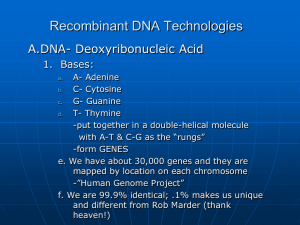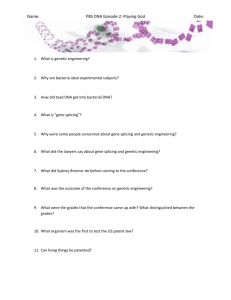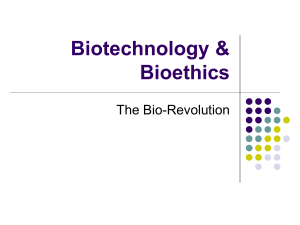Ch 15 Genetic Engineering
advertisement

1 Review Give two practical applications for both transgenic plants and animals Make Judgments List reasons why you would or would not be concerned about eating genetically modified foods 2 Review Name three uses for recombinant DNA technology Apply Concepts Medicines interact with the body’s proteins. How might normal variations in your genes affect your response to different medicines 3 Infer Why is DNA fingerprinting more accurate if the samples are cut with more than one restriction enzyme CH 15 GENETIC ENGINEERING 15.3 Applications of Genetic Engineering Have you eaten any genetically modified food lately? Agriculture and Industry Could lead to better, less expensive, and more nutritious food as well as less harmful manufacturing processes. GM (genetically modified) Crops One genetic modification uses bacterial genes that produce a protein known as Bt toxin Toxin is harmless to humans and most other animals, but kills insects Plants with the Bt gene do not have to be sprayed with pesticides. Other useful genetic modifications include resistance to herbicides, which are chemicals that destroy weeds, and resistance to viral infections. GM Animals The U.S. government approved the sale of meat and milk from cloned animals in 2008 30 percent of the milk in U.S. markets comes from cows that have been injected with hormones made by recombinant-DNA Pigs can be genetically modified to produce more lean meat or high levels of healthy omega-3 acids. Combined spider genes into the cells of lactating goats Goats began to produce silk along with their milk Silk is extracted from milk and woven into thread Also trying to put antibacterial protein in goats for kids who get sick. Preventing Disease Provitamin A deficiencies produce serious medical problems, including infant blindness Golden rice is a GM plant that contains increased amounts of provitamin A Transgenic sheep and pigs that produce human proteins in their milk. Medical Research Transgenic animals can simulate human diseases in which defective genes play a role. Treating Disease Recombinant-DNA technology can be used to make important proteins that could prolong and even save human lives Insulin, blood clotting factors, human growth hormone. Treating Disease Gene Therapy Process of changing a gene to treat a medical disease or disorder Absent or faulty gene is replaced by a normal, working gene. Researchers engineer a virus that cannot reproduce or cause harm DNA containing the therapeutic gene is inserted into the modified virus. Patient’s cells are then infected with the genetically engineered virus Virus will insert the healthy gene into the target cell and correct the defect. Genetic Testing Genetic testing can be used to determine if two prospective parents are carrying the alleles for a genetic disorder Use probes looking for disease-causing alleles Genetic tests are now available for diagnosing hundreds of disorders. Examining Active Genes DNA microarray Technology to study 100s or 1000s of genes at once to understand their activity levels. To compare the genes in cancer cells with genes in normal cells, the mRNA would first be isolated from both types of cells Enzymes are used to copy the mRNA base sequence into single-stranded DNA labeled with fluorescent colors -red for the cancer cell and green for the normal cell. Mix both samples of labeled DNA They compete to bind to complementary DNA sequences already placed in the microarray. Where the cancer cell produces more mRNA for a gene the spot will be red Where the normal cell produces more mRNA for gene the spot will be green If cell produce equal amounts of gene the spot will be yellow. DNA Fingerprinting Identify individuals by analyzing sections of DNA that may have little or no function but that vary widely from one individual to another. Personal Identification Restriction enzymes cut a small sample of human DNA into fragments containing genes and repeats Gel electrophoresis separates the restriction fragments by size. DNA probe detects the fragments that have highly variable regions, revealing a series of variously sized DNA bands If enough combinations of enzymes and probes are used the pattern of bands can be distinguished statistically from any other individual in the world. Genetic fingerprints can be used to help solve crimes (both human and non human) as well as paternity. The modified traits shown in the graph include herbicide tolerance (HT) and insect resistance (Bt) Graph is on pg 363. 1. 2. 3. 4. Analyze Data Which two crops were most widely and rapidly adopted Draw Conclusions Why do you think the levels of adoption fell at certain points of the period Predict What do you think will happen to HT soybeans and HT corn over the nest few yearswhy? Use the graph to support your prediction Infer Why do you think an increasing number of farmers have chosen to grow crops with herbicide tolerance








